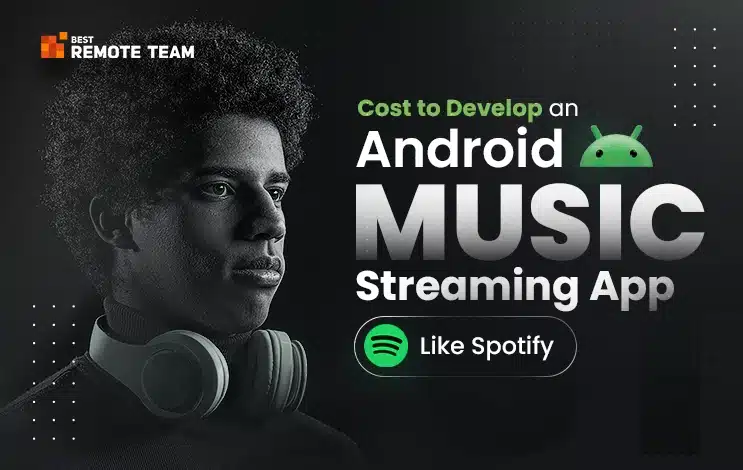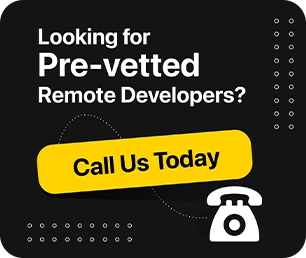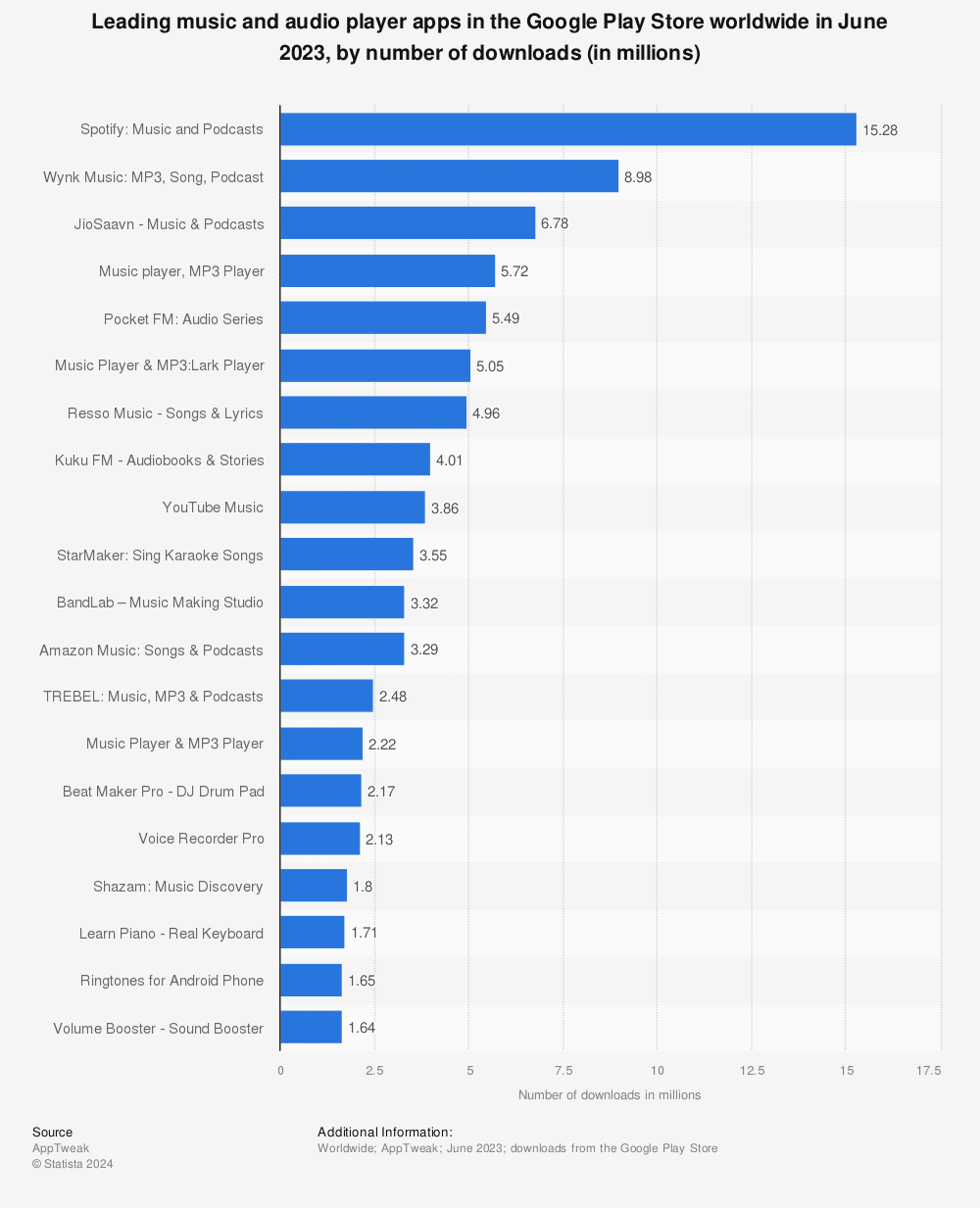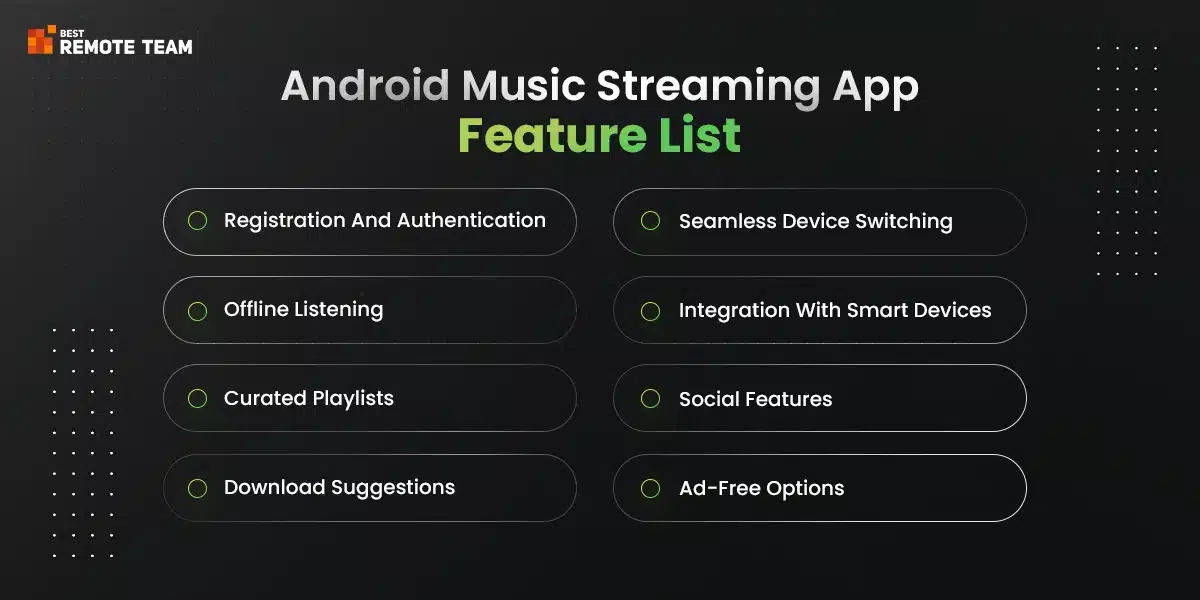Why Build a Music App for Musicians and Music Lovers?
Let’s take a step back and understand what musicians or music lovers miss in the conventional music landscape.
- If someone loves listening to music while traveling, they would want to play their favorite songs on the road. However, in the conventional landscape, they must download these songs, and prepare their systems before the trip. This is true for commuters as well.
- As a music lover, you always want to discover new songs or cultures. Content diversity is a challenge in traditional music download methods. This means your target market can listen to the songs they know or have heard.
- Moreover, traditional music listening solutions don’t offer personalized recommendations aligned with their preferences.
Let’s look at how a music streaming application can become the ideal solution for these pain points.
- Content Diversity: It will offer a platform enabling music lovers or musicians to access diverse genres and artists. As a musician, it grants you a place to widen your reach and improve your visibility as an emerging artist.
- Tailored Experiences: The application can extend personalised recommendations and playlists based on the user’s preferred songs and genres. It can also improve offline listening services.
- Connect with Musicians: The musicians can directly engage with their fans and audience. They can release their music with their fan base before others.
- Collaborative Exploration: Your music lovers can collaborate to discover and listen to their favourite genres collectively. It also helps musicians collaborate with producers and fellow artists to create shared projects.
- Plans for Subscription: Some diverse models extend exciting premium features allowing users to choose the best-fit plan.
- Monetization for Musicians: Musicians can earn money through these applications by conducting virtual concerts. They can also sell merchandise or try their hand at alternative income solutions.
- Data Analytics for Adaptive Curation: AI is integral for creating dynamic playlists that are based on the user’s preferences. This assures constant discoverability. Moreover, it helps keep the user engaged in the music. Musicians can use data analytics to understand their audience better. It helps create content that is aligned with their preferences.
Top 8 Key Features of Android Music Streaming Apps
You must implement the key features when planning the android music streaming solution. It can help you enhance the user’s experience and ensure complete satisfaction.
#1) User Registration And Authentication
This is a crucial element of your music streaming application. This allows users to create their profiles. Allow them to connect with your application using their Email or social media profiles.
A secure authentication should be in place as people will share their sensitive data while creating the profile. You must ensure proper data protection policies are in place for data storage and access.
#2) Offline Listening Capabilities
One of the biggest issues with music streaming applications is that they work with the Internet. So, if you are in a place without the Internet, you are dependent on your traditional music listening methods. You can avoid the churn caused by the unavailability of the Internet by offering offline listening.
Offer an interface where the users can easily manage the downloaded content and listen to it in the absence of the Internet.
#3) Curated Playlists For Specific Activities
You may want to listen to different song genres or artists while commuting or working out. You can create separate playlists based on your activities.
You can even share these custom playlists with your friends in the community for shared discovery.
#4) Smart Download Suggestions Based On User Preferences
You can use pre-defined algorithms based on past behaviour to analyze the user’s listening habits and preferences. This would help the application download the music for them.
You can even extend smart recommendations based on past behaviour to help them discover new music.
#5) Seamless Device Switching (Phone, Car, Speaker)
You must allow the users to swiftly switch between the various devices such as car audio, Bluetooth and speaker. It is equally important to make sure your music streaming application is compatible with the different devices and connectivity options.
#6) Integration With Fitness Trackers And Smartwatches
Your users may want to integrate the application with their trackers and smartwatches. This would help them enhance the workout experience. You must ensure compatibility with wearable and other devices.
You can implement music controls on the devices for better engagement and user experiences.
#7) Social Features Like Following Friends And Sharing Playlists
You can use this feature to connect with people with similar music preferences and share playlists. It can also help you foster a community on the application. These social sharing features will help engage the user for a longer while.
#8) Ad-Free Options
Incorporate ad-free features such as premium subscription models. You can also extend exclusive content or high-quality audio features for premium subscriptions.
Cost of Developing an Android Music Streaming App like Spotify
Several factors impact the cost definition for an Android music streaming app like Spotify. We have identified the factors and the subsequent application development cost here.
#1) App Complexity
| Type of App | Explanation | Approximate Cost |
| Simple Application | This is a standard application with basic features including simple playlist creation and basic streaming solutions | It will take about 3-6 months to develop the app. The cost is approximately $20k to $50k |
| Moderately Complex Application | When you add features like curated playlists and offline listening, it leads to a moderately complex app. | 6-12 months to develop the app. Cost is approximately $50k to $100k |
| Highly Complex Application | It is an advanced app with emerging tech like AI and wearable integration | 12+ months to develop. Cost between $100k to $300k |
#2) Features and Functionality
You must look at the development and design costs for each feature. The features will be extensive for a complex app. We will look at the cost of developing some of the crucial features of a Spotify-like application.
| Features/Functionality | Design Cost | Development Cost |
| User Registration and Authentication | $5,000 – $10,000 | $10,000 – $20,000 |
| Offline Listening | $5,000 – $10,000 | $15,000 – $30,000 |
| Curated Playlists | $5,000 – $15,000 | $20,000 – $40,000 |
| Smart Download Suggestions | $5,000 – $15,000 | $25,000 – $50,000 |
| Seamless Device Switching | $5,000 – $10,000 | $15,000 – $25,000 |
| Fitness Tracker and Smartwatch Integration | $10,000 – $20,000 | $30,000 – $60,000 |
| Social Features | $5,000 – $15,000 | $20,000 – $40,000 |
| Ad-free Options | $5,000 – $10,000 | $15,000 – $30,000 |
#3) Tech Stack
When you are planning a music streaming solution, you must look at the backend/frontend frameworks. It is equally crucial to consider the technologies and development platform while planning the app.
| Technology | Description | Cost Estimate |
| App Platform | Android (as we are looking at an Android-specific app) | Open source. No Cost |
| Backend | Node.js, Express.js, MongoDB and Firebase. This stack is scalable and full of real-time capabilities | $20k to $50k |
| Cloud Services | AWS and Google Cloud. They are scalable and adaptable. Moreover, they offer real-time solutions | $10k to $30k |
| Streaming Technology | HLS or DASH. They are renowned adaptive streaming protocols. You can use them for high-quality media | $5k to $15k |
| Payment Gateway | Stripe is the most preferred gateway. You can also use others. This cost is specific to Stripe payments | $5k to $15k |
| Frontend | React.js or Angular are great front-end frameworks. | $15k to $35k |
| DevOps | Docker and Kubernetes are mostly used for DevOps. you can also implement GitLab for efficient containerization. | $15k to $35k |
| Security | SSL/TLS certification is a must. You must also opt for OAuth 2.0 for secure data storage and transmissions. | $10k to $25k |
| Monitoring & Analytics | Google Analytics or Mixpanel. This will gather maximum user analytics and performance monitoring solutions. | $10k to $25k |
#4) Design and User Experience
The cost of extending an aesthetic and visually engaging interface must be calculated. You must also take into consideration UX design strategy as it can impact your user’s engagement.
| Design Elements | Explanation | Cost |
| Visual Elements | The elements that define the overall look and feel of the application. | $5k to $15k |
| Navigation Layout | A user-friendly and intuitive way to move around the application | $7k to $20k |
| Personalization | Personalized recommendations and tailored user experience for increased retention | $10k to $25k |
| Usability | Simple and clear instructions throughout the application that is easy to comprehend | $8k to $18k |
| Theme | Users can personalize their app interface from diverse themes | $5k to $12k |
| Customized Playlist | Users can customize the playlist based on their genre, artist and song preferences | $10k to $20k |
| Gesture Controls | Users can use gestures to interact with the app to play/pause/skip | $10k to $20k |
| Voice Commands | Allow users to interact with the app through their voice. | $10k to $20k |
| Text-to-speech | This feature will ensure content accessibility for people with diverse issues | $8k to $15k |
| Progress Indicators | Visual indicators that load the progress for a seamless app experience | $5k to $12k |
#5) Licensing and Legal Considerations
You must ensure adding the legal costs to your estimates. It can help you plan the cost of an Android app better.
| Licensing and Legal Considerations | Explanation | Cost |
| Music Licensing | This is crucial as you are a music streaming app. You must take the license to stream the different copyrighted music. Costs majorly depend on the agreements and other factors. | $50k to $500k |
| Legal Consultation | You must work with legal experts who will help understand data protection and copyright laws | $15k to $30k |
| Compliance Audits | Conduct regular audits to ensure your streaming app adheres to regulations like GDPR and others. | $10k to $20k |
| Contractual Agreements | You must define the legal fees for signing contracts with record labels and artists. | $20k to $50k |
| Intellectual Property Protection | You must safeguard the application using trademarks and copyrights. | $10k to $25k |
#6) Development Team (Roles and Skills)
You need a good development team to stand by you while planning and developing the application. It is crucial to estimate the cost of hiring a developer. This depends on the region and skill set of the developer. You must hire Android music streaming app developers with the best skills and proficiency to build a suitable application.
| Resource’s Role | Hourly Rate (Low to High) |
| Project Manager | $30 to $120 |
| Android Developer | $25 to $100 |
| Backend Developer | $30 to $110 |
| UI/UX Designer | $25 to $100 |
| QA Engineer | $20 to $80 |
#7) Testing
You must invest in thorough testing to ensure a proper quality product. Each aspect of testing requires resources and infrastructure. You must identify the individual costs before planning your testing.
| Testing | Explanation | Cost |
| Manual Testing | A comprehensive testing was conducted by the QA team to identify and address usability issues and bugs. | $15k to $30k |
| Automated Testing Tools | Implementing automation workflows to increase testing efficiency. It helps reduce the repetitive testing tasks | $10k to $20k |
| Compatibility Testing | You can verify the app’s performance across browsers and devices for consistent solutions | $8k to $15k |
| Security Testing | A detailed security test to determine and mitigate the vulnerabilities for comprehensive data protection | $12k to $25k |
| Performance Testing | Use this approach to test the app under diverse conditions to check if it can manage the loads and accelerate responses | $10k to $20k |
| User Acceptance Testing | Validate the app’s usability, customer satisfaction and functionality | $8k to $15k |
#8) Maintenance
You must invest in regular app maintenance and updates for the best outcome. This can ensure better security and longevity of the application. Here is a cost breakup for maintenance and support services.
| Maintenance | Explanation | Cost |
| Bug Fixes and Updates | Update the app regularly to identify bugs, enhance the features and ensure compatibility with the latest OS and device versions. | $15k to $30k annually |
| Security Patches | Continuous monitoring and implementation of security patches that address vulnerabilities | $8k to $15k annually |
| Server Maintenance | Server upkeep and maintenance. Regular monitoring and optimization to ensure best load management. | $10k to $20k annually |
| Technical Support | Provision for customer support to ensure quick resolution of technical issues. It can also help manage user queries | $12k to $25k annually |
| Feature Enhancements | Add features and improvements using customer feedback and the latest trends to enhance customer experience | Depends on project’s requirement |
Cost Optimization Strategies
Cost optimization is crucial if you wish to stay within the planned budget. There are different approaches to choose that help with optimizing the costs and effective planning.
#1) Outsourcing vs In-house Development
Your development approach is pivotal in defining the budget for your application. If you go with in-house development, you face the overhead of hiring the resources and managing them.
You may also face infrastructure costs and other maintenance expenses. However, as they work in-house, you may have full control of the project. It also helps with long-term ownership.
On the other hand, outsourcing allows you to access global talent and launch your apps faster. However, you may face quality and communication issues if you have not implemented an effective protocol.
Depending on your defined budget, development timelines and other factors, you must choose an approach that works best. You can also outsource non-critical yet time-consuming tasks while managing the critical ones in-house.
#2) MVP (Minimum Viable Product) Approach
This is an effective approach if you want to reduce overheads while gaining validation from the market. You can accelerate time-to-market while reducing development costs.
As you can gain feedback from users in the early development phases, you can build a user-centric application.
The only flip side is you will develop an app with limited features. Moreover, you may overlook critical app functions while planning an MVP.
You must use a strategy where you gather the basic requirements and plan an app around this. Once you have user feedback, you can enhance the solution using the insights.
#3) Native App Development vs Cross-platform Solutions
You can also choose to develop an Android-only or iOS-first application before committing to the other platform. If you want to check which market works better for you, you can go with a cross-platform application.
When you choose native music app development, you ensure optimal performance with platform-specific features. However, this may increase your development costs. Moreover, you need to develop separate codebases for each platform.
In the case of cross-platform solutions, you build a single codebase and reuse it for all platforms. It offers a more cost-effective and accelerated development.
The only flip side is you are dependent on third-party frameworks for the application development. Moreover, you may face performance issues with cross-platform solutions.
How to Make Money with Your Music App?
It is important to determine ways to make money with the music application. Here we will take you through the four important and sustainable monetization methods for streaming services.
#1) Freemium Model
The basic version of the streaming application is available for free. It includes basic features. Your user can seek a premium version with specific features using the subscription plan that works for them.
The revenue is generated monthly or annually for your business. You can add ad-free experiences, higher audio quality or exclusive content as part of the premium subscription.
Offering a tiered subscription plan can ensure your plan is tailored for the diverse customer types.
#2) In-app Purchases
You can offer additional content as part of your application, including exclusive tracks and special playlists. This would add some revenue to your business via one-time purchases.
You can create a virtual store on the application for users to purchase their features and implement them in the streaming application.
#3) Advertising
You can use display ads in the application to generate revenue. You will get money from the advertisers for the clicks or impressions on the ad. These ads can improve the visibility of the brands and offer you extensive monetization opportunities.
#4) Partnerships and Integrations
You can collaborate with music labels and businesses for robust partnerships. This can help improve revenue generation. Co-branded playlists and sponsored content can help you maximize revenue.
Future Trends and Innovations
Emerging technologies and trends will impact future trends and innovations in the music streaming app industry.
#1) AI-based Recommendations
AI and ML will extend personalized music recommendations within streaming applications. This will enhance user engagement by ensuring easy discovery of new music. Your users can personalize the playlists to meet their individual preferences and listening habits.
#2) VR-based Concerts
You can integrate VR into music streaming solutions to ensure live concerts and performances in the virtual zone. You can create immersive music experiences. It can blur the geographical boundaries and allow users from all places to enjoy the music.
#3) Blockchain-driven Streaming Platforms
Blockchain technology helps drive transparent and secure music distribution. This allows you to ensure fair compensation for all the artists on the streaming platforms.
This application combined with Blockchain technology allows decentralized music distribution and enhanced royalty tracking. It can also reduce the app’s reliance on intermediaries.
#4) Voice-activated Interfaces
Integrating voice commands can help manage the application without using hand movements or finger interactions. It can increase the accessibility of the application and improve interactions.
#5) Interactive Music Content
You can add interactive elements like clickable hotspots or interactive albums. This would lead to immersive content and ensure better engagement.
Conclusion
An Android music streaming app like Spotify can cost you anywhere between $50k to $300k depending on the complexities, development team and approach. You must define the app requirements, the target audience and all requisite data before getting started.
competition analysis is crucial to identifying the best requirements for your Android application development. Once you have a defined scope, it is easier to estimate the app budget. You will know the exact infrastructure you need and the total resources to develop your application.
Best Remote Team can support you with their Android team. The Android app development services are perfectly vetted to suit your needs.
Connect with our team with your requirements and see how we help you find the right development partner.







